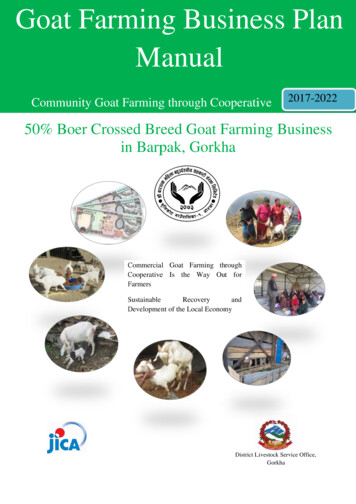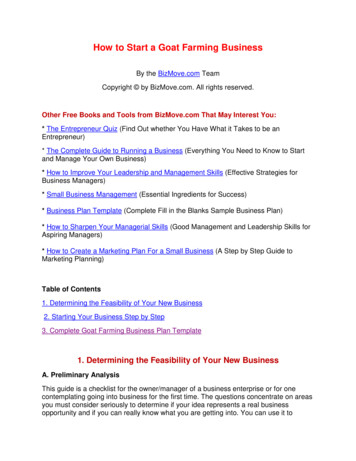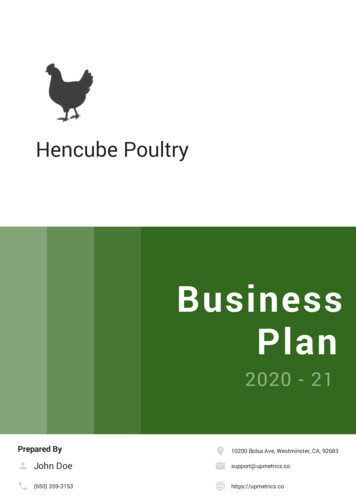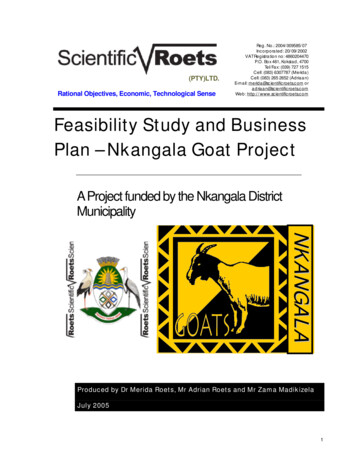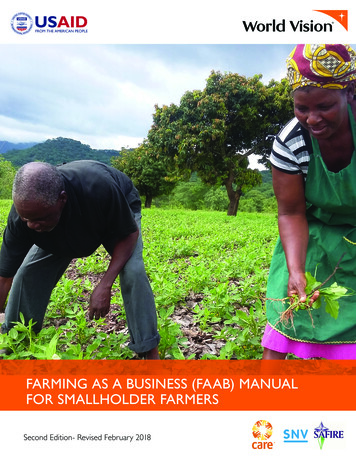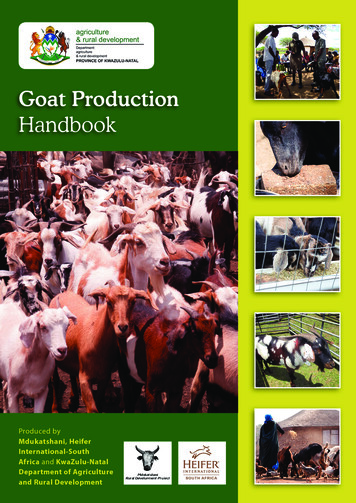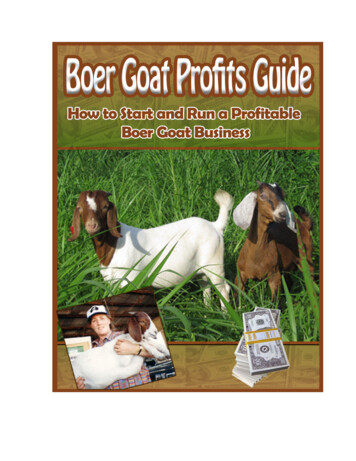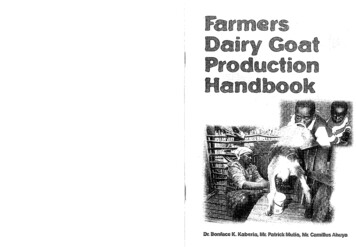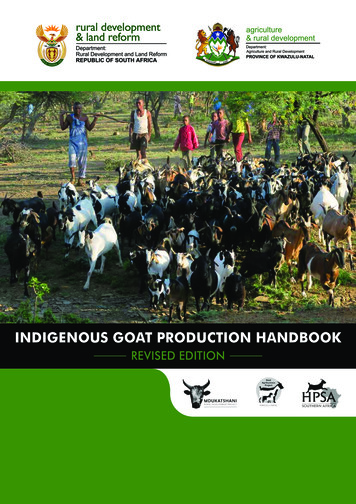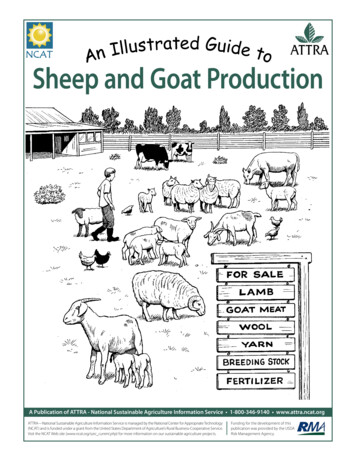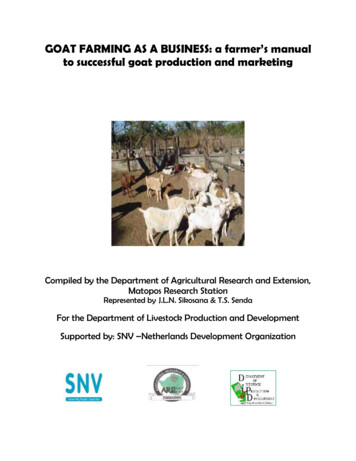
Transcription
GOAT FARMING AS A BUSINESS: a farmer’s manualto successful goat production and marketingCompiled by the Department of Agricultural Research and Extension,Matopos Research StationRepresented by J.L.N. Sikosana & T.S. SendaFor the Department of Livestock Production and DevelopmentSupported by: SNV –Netherlands Development Organization
ACKNOWLEDGEMENTSThe Department of Livestock Production and Development (DLPD) in collaboration with theDepartment of Agricultural Research and Extension (AREX), Matopos Research Station wouldlike to acknowledge the support and facilitation by the Netherlands Development Organization(SNV) in the development and production of this manual. We extend our appreciation to thefarming communities in Matabeleland South and North Provinces, for sharing their practicalexperiences that enriched the content of this manual.This manual was produced with the expertise from the following contributors: Adolf. B. Dube,(Chief Provincial Livestock Specialist-DLPD), Nicholas Nyathi, (Senior Advisor EconomicDevelopment-SNV), Darlington Sarupinda, (Advisor Economic Development-SNV), MbekezeliMthunzi, (Advisor Economic Development-SNV) Nozipho P. Ncube, (Livestock Specialist –DLPD), Mario Zondani, (Livestock Specialist –DLPD), Sakhiwe Khanye, (Livestock ExtensionWorker-DLPD), Farai Tavesure, (Marketing Intern-SNV), Brighton Ngwenya, (LivestockExtension Worker-DLPD) and Velaphi Mhlanga, (Livestock Extension Worker-DLPD).Goat farming as a BusinessiMRS, SNV, DLPD
CONTENTS1.0 Introduction2.0 Entrepreneurship2.1 Characteristics of an entrepreneur.PAGE123.0 Breeds3.1 Types of breeds3.2. Other breeds34.0 Management of does and bucks.4.1 Management of females.4.2 Management of males105.0 Breeding5.1 Breeding systems.5.2 Mating systems5.3 Selection and culling5.4 Breeding calendar5.5 Buck to doe ratio126.0 Kid management.6.1 Kidding season.6.2 Kid rearing167.0 Husbandry Practices.7.1 Housing7.2 Detention.7.3 Hoof trimming.228.0 Goat Nutrition8.1 Feed Requirements.8.2 Digestive System8.3 Fodder production and conservation.9.0 Crop livestock production system.10.0 Health.10.1 Dipping10.2 Dosing/Drenching10.3 Injections11.0 Goat Business Management11.1Goat marketing11.2 Financing goat business.11.3 Business planning.12.0 Record keeping.12.1 Physical records.12.2 Financial recordsReferences.Goat13.farmingas a Businessii263334455254MRS, SNV, DLPD
1.0 INTRODUCTIONThere are more than 3 .5 million goats in Zimbabwe, of which 98 per cent are indigenous breedsand owned by the smallholder farmers.Most of them are kept in the drier agro -ecological zones in Natural Ecological Regions IV and V and in Tse -tse infested areas .NaturalRegion IV has a low rainfall subject to periodic droughts and extended dry spells. Overall, theimportance of goats increases as the rainfall decreases. Goats are hardy and easier animals to lookafter, which can survive under harsh environments.Goats are reared under extensive farming conditions, mainly for meat (chevon) and to a lesserextent for milk. To some extent productivity of these goats is low due various factors such ashigh kid mortality and lack of good animal husbandry practices. Goats also provide skins ofcommercial importance and manure for gardens (and crop fields). In other parts of the worldgoats are kept for their wool (mohair).Human populations are growing, and creating a significant and increasing demand for additionalanimal protein foods. The goat can play an important role in meeting these demands. This callsfor farmers to put value in their goat enterprises by shifting from subsistence production tocommercial production. It is easier to increase the population of small ruminants (goats andsheep) than large stock. In economic terms the opportunity costs are low for goat production.“The goat was probably the first animal to be domesticated around 9000-7000B.C. This long association between goat and human indicates the variety offunctions the goat can provide.”This manual has been written to provide information to farmers who are in need of knowledge tostart a goat enterprise on a commercial basis, and goat husbandry. The information is notcompletely comprehensive, but combines experiences from authors and farmers.Goat farming as a Business1MRS, SNV, DLPD
2.0 ENTREPRENUERSHIPObjectivesBy the end of the session farmers should be able to: Exhibit entrepreneurial competencies needed to run a successfulcommercial enterprise.Introduction.An entrepreneur is a person who continuously identifies opportunities in the market for productsor services and then develops new products and services to satisfy the identified needs. As anentrepreneur one needs to visualize a successful goat business and then commit resources toachieving the set goals.Most producers have the “Imbuzi ziyazibonela (The goats should look after themselves)mentality. They do not realize the value of goats, their total worth and how much more theycould contribute to their livelihoods if well managed as a business enterprise.For the smallholder goat producers to run successful commercial goat enterprises they need: To understand that starting a business has some risks; Access adequate knowledge and information; To identify opportunities; To commit time and resources; and To be ambitious and set goals that are achievable.Characteristics of entrepreneurshipThe entrepreneurial abilities that one needs to develop in order to be a successful commercialgoat producer are identifying business opportunities, calculated risk taking, goal setting,information seeking, commitment to a business plan, persuasion and networking, and systematicplanning and monitoring.1. Identifying a business opportunityThe key is the ability to see opportunities in business or personal life where others do not. Anopportunity is therefore a chance, an opening or prospect, which avails itself.Thus an entrepreneur is anyone who identifies problems, resources and unmet needs in societyand develops these into business ideas. Thus generating business ideas is the first step in businesscreation. Examples of entrepreneurs are:Goat farming as a Business2MRS, SNV, DLPD
A farmer who identifies the need for supplementary feeding and goes on to store the feed andsell it to other farmers during the dry season. A group of farmers who realize that the shortage of beef is an opportunity for them to sellmore slaughter goats. They organize themselves, hire a truck and transport 50 goats permonth for sale in Bulawayo. A trader who buys goats from the small-holder farmers and sells them to abattoirs inBulawayo and Harare.What goat business opportunities are available in your area? Use the tool below to identify yourbusiness opportunities in the goat sub-sector.Problemse.g. Shortage of meatBusiness ideaBuy and sell goats to abattoirsResourcese.g. GoatsBusiness ideaImprove condition and sell to retailshops in BulawayoUnmet needsBusiness idea2. Calculated risk takingOnce an opportunity is identified, matched with one’s capabilities, it is then necessary to take acalculated risk. When one is taking a risk, it is a matter of striking a balance between success andfailure. Risk can be minimized by seeking information and making informed decisions.Most goat producers are scared of taking risks because of the following reasons: They might lose their savings; They are not sure whether the goat enterprise will give them a return; and They do not have information on available opportunities.A good illustration of risk taking is that of goat traders. They undertake tasks that mostsmallholder goat producers do not want to undertake on their own. The traders incur costs thatGoat farming as a Business3MRS, SNV, DLPD
include buying, transportation, pre-financing, personnel costs (for buyers/ herders) andslaughtering fees.Exercise: What calculated business risk have you ever taken in your life? Write down the event below.What happened and how did it happen? 3. Objective settingAn objective is defined as a specific and measurable achievement to be attained within a specificperiod of time and cost constraint. A well-defined objective statement is the foundation for goalachievement. Objectives are set to give direction, motivate one to work hard, assist one to bewell organized and as monitoring tools.An objective states the following: What is to be achieved?By who?By when?Where?Objectives should be specific, measurable, achievable, realistic and time-bound (SMART)Example of an objective that is not Example of a SMART objectiveSMART“I want to have more money”.“I will sell 5 goats directly to TITIrestaurant by September, leading to anincrease in my income by 100 %.Goat farming as a Business4MRS, SNV, DLPD
Exercise:Write a SMART objective for your goat enterprise: Taking your objective as it is, if achieved what would it bring to you? 4. Information seekingAn entrepreneur should access new technologies and other factors that affect their goatbusiness.The information gathered will: Shape the business plan; Help reduce risk; and Enable the entrepreneur to make better/ informed decisions.There are a number of information gathering methods that can be used. These are: Desk research; Interviews; Questionnaire; and Observation.The sources of information include business magazines, books, government records, electronicmedia (radio and television), Business Development Service (BDS) providers such as One-Upand Women-In-Business, Internet services, competitions (fairs and shows), buyers, suppliers,other farmers and newspapers.Exercise:What are the prices of goats at the local sale points?What are the prices of goats in the nearest urban centre?What business decision would you make based on this information? Goat farming as a Business5MRS, SNV, DLPD
The sources of information include Farmer Magazines, books, relevant government departments,electronic media (radio and television), competitions (fairs and shows), buyers, suppliers, otherfarmers and newspapers.5. Commitment to the business planOnce one has a business plan in place there is need: To stay focused; To be committed to the tasks ahead; To adhere to a set work plan; Motivate and provide leadership to the people you are working with on the goatbusiness.Exercise: Write your plans for your goat business for the coming 12 months. 6. Persuasion skills and networkingBuyers or abattoirs do not just buy your goats. It is your responsibility (individually or as aproducers’ association) to remind them about the availability of your goats or goat products.This can be done through face-to- face meeting with your clients, advertising and constantcommunication with suppliers and buyers.Through persuasion and networking you build strong business relationships. Strong businessrelationships are built on trust, interdependence, fair decision making process, balanced powerstructure, shared goals, equitable returns, problem solving process, and commitment.Exercise: Give an example of a situation where you have managed to persuade buyers to purchaseyour products? Goat farming as a Business6MRS, SNV, DLPD
List the different stakeholders you are interacting with and are relevant to your business. 7. PersistenceThe goat business is full of challenges. You must not give up when the going gets tough. Anobstacle can be turned into an opportunity. What is needed is the ability to persevere and quicklyadapt to changes taking place. One also needs to be flexible.When you lost some of your kids/ goats, what did you do? 8. Independence and self confidenceWhen one takes up goat production as a business he/ she needs to: Be their own boss;Have a desire to transform their dreams into reality;Have self belief;Be free to make decisions; andStrive to achieve financial independence.9. Systematic planning and monitoringFor the effective planning and monitoring of the goat business write up a business plan thatanswers the following questions: Step I: Where am I now? (current situation)Step II: Where am I going? (future/ desired situation/ Mission/ objectives )Step III: What is between here and where I want to go? (The business environment)Step IV: What is the best way for me to get there? (strategic options)When the planned actions will be done and how do I know that I am making progress?(Monitoring Plan and milestones)Goat farming as a Business7MRS, SNV, DLPD
3.0 Goat BreedsObjectivesAt the end of this session farmers should be able to: Identify the breeds found in Zimbabwe and their attributes Choose the appropriate breeds for their goat farming businessesTYPES OF BREEDS The vast majority of goats in Zimbabwe are indigenous and these are mainly the largeMatebele and the Small East African (SEA) goat Average birth weights of kids range from 1.5kg to 2.5kg. (up to 3kg) The indigenous breeds are well adapted to their respective environments.Goat farming as a Business8MRS, SNV, DLPD
In the southern partsof Zimbabwe, thereare larger goats, whicharetermedtheMatebele goat with amature weight of45kg.Other breeds found in Zimbabwe include exotic types, the Boer goat (mainly
For the effective planning and monitoring of the goat business write up a business plan that answers the following questions: Step I: Where am I now? (current situation) Step II: Where am I going? (future/ desired situation/ Mission/ objectives ) Step III: What is between here and where I want to go? (The business environment)
